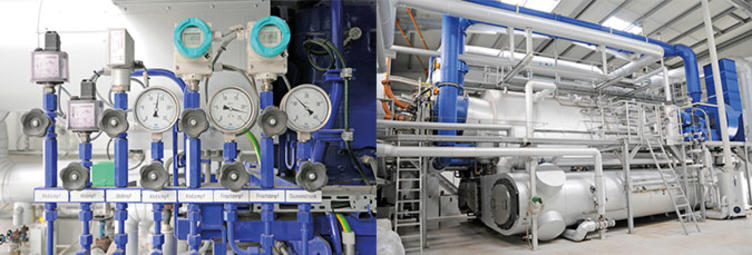Rising energy costs & transition
toward renewable energies
Rising energy costs & transition
toward renewable energies
Because of their excessive energy usage, energy-intensive industries have the reputation of being a “climate killer”. However, as a role model in international climate protection, the German industry has invested heavily in new energy-saving and emission-lowering technologies. In so doing, it has achieved, for example, a reduction of greenhouse gases by nearly 20 percent between 1990 and 2008. Innovative energy supply technologies used by energy-intensive industries contribute significantly to this positive development.
Features of energy-intensive industries
Each year, energy-intensive industries generate sales in excess of 311 billion Euros. Translated to the sales generated by all manufacturing trades, this amounts to 17 percent. More than 12 billion Euros are invested each year in Germany, along with more than 16 billion Euros for energy.
EIIs are characterized by:
- strong national as well as international performance
- increase in growth as well as high employment figures
Energy-intensive industries (EII) are lines of business working with building materials such as chemicals, paper, glass, steel and other non-ferrous metals. These branches of industry are at the beginning of the value chain, as they require disproportionately greater amounts of energy than many other lines of business, to manufacture e.g. products and materials such as aluminium, tin, copper, synthetic materials, insulating materials and many chemicals. Paper, cardboard, glass, lime and cement as well as ceramic products are also part of the EII, consuming large amounts of energy.
Branches of energy-intensive industries in Germany:
- Chemical industry
- Steel
- Non-ferrous metals
- Paper
- Glass
- Building materials
Energy-intensive industries create new jobs
EIIs are jointly responsible for the establishment of downstream production sites and indirectly create a considerable number of workplaces. Close to 830,000 people are employed in this branch of industry in Germany. Each energy-intensive production job generates an equivalent of two workplaces in other sectors, including in the service sector.
Energy-intensive industries as economic engine
In so doing, energy-intensive industries supply versatile and important raw materials and substances for various innovative industries of the future in Germany. These not only include research and photovoltaics but also the realisation of new energy concepts and the transition to renewable energies. In fact, materials from this industry are being used to renovate and insulate buildings and for new homes with low energy coefficients.
For example, to create a wind wheel, fibre glass and chemicals-based coatings from the EIIs are used in addition to steel and copper wires. Materials from EII productions also have a high significance in the important fields of logistics, mobility and communication, be it for power grids, pipelines, antennas or luminous material.
EIIs are committed to sustainable climate protection
EII materials are likewise used in energy-conserving productions such as for green buildings, electric cars and energy-efficient electronics and household appliances as well as in production facilities for wind and solar energy. Therefore, EII spokespersons have recently started raising concerns that their industry is unduly burdened by excessive policy-related additional costs.
The following is the key aspect: The cost factor is very high for the energy and power consumption of energy-intensive industries. The electricity rate in Germany includes high duties and special contributions. Therefore, the EIIs are asking to be exempt from this regulation to help secure the international competitiveness in this branch of industry with lower energy costs. According to the National Office for Statistics, the energy costs for example in 2008 amounted to 57% for the aluminium production, 47% for the cement manufacture and 36% for the steel industry.
Federal politicians have responded to the objections from the EIIs, because significant differences in electricity rates can represent a substantial economic competitive disadvantage. Without exceptions for taxes, duties and contributions paid in Germany, the electricity rate is very high, especially for companies working in the energy-intensive industries, particularly when compared to most other EU member states.
Affordable energy costs represent a vital factor
For this reason, these companies are granted discounts and compensation for their high costs incurred in particular as a result of duties for renewable energies, grid costs and electricity prices. Since 2013, they have been reimbursed for part of the higher electricity costs they incurred as a result of emissions trading.
Thanks to this approach involving compensated electricity prices, the competitiveness of companies working in the energy-intensive industries such as chemicals and steel manufacturers has markedly improved. In addition, targets and efficiency adjustments are regularly stipulated to achieve further energy savings and to optimise production processes.
Since 2014, these decisions have been aimed at consistently preventing the weakening of energy-intensive industries as well as the movement of productions to locations outside the EU, which offer lower energy costs and environmental standards and would thus result in a further increase in global emissions and the greenhouse effect.
Our international services: Energy-intensive industries
We embody partnership –
find your contact.
With more than 70 locations throughout Europe, we are always at your doorstep.
Contact us. We are here for you.
